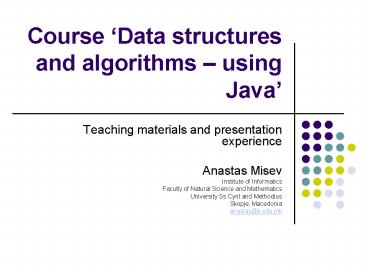Course Data structures and algorithms using Java - PowerPoint PPT Presentation
1 / 20
Title:
Course Data structures and algorithms using Java
Description:
Course Data structures and algorithms using Java' Teaching materials and ... for each lecture and tutorial, a topic to discus its quality will be posted. ... – PowerPoint PPT presentation
Number of Views:970
Avg rating:3.0/5.0
Title: Course Data structures and algorithms using Java
1
Course Data structures and algorithms using
Java
- Teaching materials and presentation experience
- Anastas Misev
- Institute of Informatics
- Faculty of Natural Science and Mathematics
- University Ss Cyril and Methodius
- Skopje, Macedonia
- anastas_at_ii.edu.mk
2
Agenda
- The course
- Syllabus
- Bibliography
- Evaluation
- Grading
- Teaching materials
- Assignments
- Projects
- Students feedback
3
The course
- Basic course in data structures and algorithms
- 4th semester
- Course delivered via moodle at http//courses.ii.e
du.mk - Preceded by a course in programming languages
(where Java is introduced) in the 3rd and two
more introductory programming courses (1st and
2nd semester) - 2 hours of lectures 1 hour tutorial 2 hours
labs - Lectures and tutorial combined
- English slides with Macedonian presentation
4
Supporting site (moodle)
5
Syllabus
6
Syllabus (cont.)
7
Bibliography
- Preiss Bruno Preiss, Data Structures and
Algorithms with Object-Oriented Design Patterns
in Java, John Wiley Sons, also available on
line at http//www.brpreiss.com/books/opus5/
(with email permission to use all resources) - Watt-Brown David Watt and Deryck F. Brown, Java
Collections, An Introduction to Abstract Data
Types, Data Structures and Algorithms, John Wiley
Sons (Material permitted to be used with
notices, http//www.dcs.gla.ac.uk/daw/books/JC/in
dex.html)
8
Evaluation
- Weekly assignments
- Performed during the labs and uploaded
- Programming or essay
- Projects
- More complicated programming and/or essay
assignments - Colloquia (recommended)
- Consist of practical and theoretical part
- Each part is passed with minimum 50
- Passes both practical parts no practical
(written) exam - Passed both theoretical parts no theoretical
(oral) exam - Practical exam
- Oral exam
- Activity during the course
- Using the moodle system, for each lecture and
tutorial, a topic to discus its quality will be
posted. The students with the most constructive
and critical comments will be awarded up to 20
extra points
9
Points
10
About the grading
- Weekly assignments are mandatory
- Dye date will be announced with each assignment
- No late submissions
- Projects are mandatory
- Dye date will be announced with each assignment
- No late submissions (or lower grading based on
the time passed the dye date) - The course can be passed either through colloquia
or written and oral exam. - Activity during the course is optional, but
recommended for the students aiming for higher
grades - The grading will be performed according to the
following table
11
Grading scheme
12
Teaching materials
- Power Point presentations
- Given in English
- Most of the students did not mind
- Some commented about the language
- Books listed
- Some additional material in Macedonian, regarding
dynamic programming
13
Assignments
- 10 weekly assignments
- Supposed to be done during the labs
- Usually complement the labs
- Most of them were programming tasks involving a
variation of the tasks done at the labs - Submission rate was relatively high
14
Assignments (cont)
15
Projects
- More advanced assignments
- Require individual work
- Project 1
- Common to all students
- Tree of arithmetical expressions
- Demonstrates the knowledge of several important
data structures (from file to tree, then to
postfix and finally evaluation) - Deliverables include programming code, sample
input and output files and essay in .doc.
16
Projects (cont.)
- Project 2
- Individual projects
- Student were asked to choose category of problem
that they would like to do - 4 categories
- Programming problems (max 30 points)
- Visualization applets (max 30 points)
- Additional programming examples of data
structures (max 20 points) - Enhancement of the teaching materials (max 15
points) - Most often the first and the last were selected
17
Students feedback
- The first time this course was delivered using
this method - Also, the first course delivered by the teacher?
- Students feedback was more than welcome
- For each topic presented, a discussion topic was
posted in a special forum for the quality of the
teaching and the materials
18
Students feedback (cont.)
- Almost all topics had some discussion attached
- Most of the comments were proposing integration
of more examples into the slides - Some were concerning errors in the examples with
programming code - Only last couple of topics were with no comments
(I suppose the enthusiasm degrades toward the end
of the semester) - All the comments were carefully read by the
teaching stuff and when necessary a response was
posted promptly
19
Future work
- The course was given to the last generation using
the previous curriculum - In the new one, the Programming languages course
is omitted - This means that the introduction to Java will be
done in this course - Fortunately, the number of hours per week
increased to 3 2 2 (giving 1 more lecture and
1 more tutorial hour) - The course is changed with the addition of 7 new
topics regarding Java fundamentals, that will be
covered in the firs 3-4 weeks - On the next years workshop will share the new
experiences ?
20
Questions and comments

